|
4/21/2014 Pelvic FloorThe pelvic floor is an important and often overlooked part of the body that holds the abdominal organs in place. Often times the pelvic floor can be chronically tight and when a teacher asks you to engage Mula Bandha, you may wonder what in the world that is, firs off. Secondly it is difficult to engage a set of muscles that are already chronically tight. As we age, these muscles may loose their elasticity (especially if they are held in chronic contraction for many years on end) and a host of pelvic issues may result, including incontinence. This week we will learn to access the pelvic floor from the lower belly and begin to feel how the movement of the pelvic floor mirrors another muscular wall in the body, the diaphragm.  Chant UUU Sit comfortably with the legs crossed. Begin to breathe into the lowest belly, way down to the area behind the pubic bone. As you exhale chant UUU in a low pitch to activate the pelvic floor, repeat for 1 minute. Elevator Breath Begin watching the breath and imagining that the breath is like an elevator car. Where it comes into the nose is the penthouse and the pelvic floor is the basement of our imaginary building. As you inhale feel the breath move down the elevator shaft in the center of the body from the penthouse (nose) to the basement (pelvic floor). As you exhale feel the breath move up the elevator shaft from the pelvic floor back up and out through the nose. Repeat this for a few rounds until it becomes comfortably. Then begin to add a slight lower abdominal contraction on the exhale only and notice if there is a corresponding lift to the pelvic floor. When you inhale, make sure to completely relax the belly. The pelvic floor should mirror the movement of the diaphragm, when you inhale they both dome downward, and when you exhale they both gently lift toward the crown of the head. Reclining Vinyasa I Begin lying on the back with the legs straight and arms extended over the head, take an inhale to prepare. Exhale and draw the right knee into the chest, holding it with the right hand. Inhale draw the right knee out to the right side with the right hand, left hand in cactus on the floor. Exhale and cross the right knee over to the left side of the body with the left hand, right hand in cactus on the floor. Inhale back to the center and extend the right leg up toward the ceiling, holding behind thigh with the clasped hands. Exhale draw the right knee to the chest. Inhale extend the leg to the floor and the arms overhead. Exhale and repeat the entire sequence with left leg. Spider Walk Lie on the back with a folded blanket under the sacrum. Draw the wide knees into the chest and hold behind the knees, keeping the ankles flexed. Inhale and straighten one leg out to the side, exhale and bend that leg. Repeat alternating sides for about a minute. 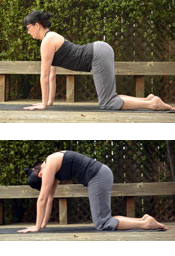 Cat/Cow Tilts: Cow: Begin on the hands and knees, toes pointed. Inhale lift the sternum forward and drop the pubic bone back between the legs to arch the spine. Feel how the pelvic floor opens in this position. Cat: Exhale round the back and drop the head and tail bone towards the floor. Feel how the pelvic floor tightens in this position. Repeat with your breath 10 times.  Sphinx Lay on belly with legs together and toes pointed back. Bring forearms to floor with elbows aligned under shoulders and forearms parallel to each other, palms facing down. Lift sternum forward and up through crown of head. If lower back feels vulnerable, engage belly away from floor. Do not contract the pelvic floor and see if you can return to the sensation of the pelvic floor moving down in inhale and up on exhale. Hold 5-10 breaths and release chest to floor with hands under forehead. 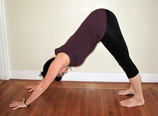 Adho Mukha Svanasana (Downward Facing Dog) Begin on all fours with hands slightly forward of shoulders. Turn toes under and lift knees off the floor. Keep shoulders wide and palms flat, press thighs and sit bones back, scooping belly in. Feel how the four bones of the pelvic base, the two sit bones, the pubic bone and the tail bone all reach up toward the ceiling. Hold 1-3 minutes, release onto the hands and knees. 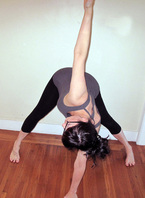 Airplane Begin standing with feet wide apart. Inhale and raise arms out to sides of body. Exhale and bring left hand down to floor, block or chair as you twist the torso to the right, grounding the left sit bone back. Inhale return to standing with arms out to the sides of body. Exhale and bring right hand down to floor, block or chair as you twist the torso to the left, grounding the right sit bone back. Repeat 5 times.  Squat Bring feet hips width apart and bend knees dropping hips down towards heels. If heels are not able to come to the floor, you can use a folded blanket under the heels. You may also sit on a block for added stability. Place palms together at the heart in Anjali Mudra. Lift the chest and relax the tailbone, feel the opening of the entire pelvic floor. Hold for 5-10 breaths. Ardha Navasana (Half Boat) Sit on the floor with a block behind you on the mat. Lean back on the edge of the block and bring the feet onto the floor in front of your pelvis. Hold behind the knees and lift the feet off the floor by engaging the belly strongly. Stay here or extend one leg straight, then the other leg, then both legs. Keep lifting chest and drawing the belly up and in. Hold for 3-5 breaths.  Setu Bandha (Bridge Pose) Lie on back with knees bent and feet hips width apart. Inhale and lift hips away from floor, rolling onto upper back. Place block under pelvis and rest sacrum on block. Turn toes slightly in and rest arms on floor with palms up. Hold 5-15 breaths and release.  Legs up the Wall Sit beside wall. Swing legs up wall as you lay back on mat. Rest hands on lap, belly or place arms out to sides with palms facing up. Rest at least 10-15 minutes, then roll over to release. The back should be relatively flat on the floor and the legs can be slightly bent, especially if the hamstrings are tight.
0 Comments
The inner and outer thighs are the subject of our weekly yoga session. As you can see in the Vitruvian Man image, the legs have the ability to move away from the center (abduction) and towards the center (adduction). Some of the muscles responsible for these movements are also responsible for internal and external rotation of the thighs with the hip sockets. They are all important for the stability of our bodies in a standing position and it is important to balance strength and flexibility to ensure healthy range of motion for the hip. Reclining Vinyasa I Begin lying on the back with the legs straight and arms extended over the head, take an inhale to prepare. Exhale and draw the right knee into the chest, holding it with the right hand. Inhale draw the right knee out to the right side with the right hand, left hand in cactus on the floor. Exhale and cross the right knee over to the left side of the body with the left hand, right hand in cactus on the floor. Inhale back to the center and extend the right leg up toward the ceiling, holding behind thigh with the clasped hands. Exhale draw the right knee to the chest. Inhale extend the leg to the floor and the arms overhead. Exhale and repeat the entire sequence with left leg. Reclining Vinyasa II Lie on the back with the legs extended. Exhale and draw both knees into the chest being careful not to arch the back as you do so. Inhale and draw the knees apart, exhale and draw the knees back together. Inhale lean the knees to the right but not all the way to the floor, exhale contract the belly and bring the knees back to the center. Inhale lean the knees to the left, exhale contract the belly and bring the knees back to the center. Inhale extend the legs straight up towards the ceiling as you raise the arms overhead, exhale and draw the knees to the chest. Inhale and lengthen the legs to the floor as you raise arms overhead. Repeat up to 5 times with the breath. Spider Walk Lie on the back with a folded blanket under the sacrum. Draw the wide knees into the chest and hold behind the knees, keeping the ankles flexed. Inhale and straighten one leg out to the side, exhale and bend that leg. Repeat alternating sides for about a minute. Strap Supported Wide Leg Stretch Lie on the back with a folded blanket under the sacrum. Bring knees into chest and strap both arches of the feet. Extend legs towards ceiling and straddle the legs on the inhale using the strap to keep legs from going too far apart. Exhale pull down on ends of strap and draw legs together. Repeat up to 10 times with the breath. 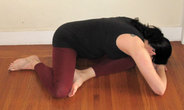 Z-Pose Pigeon Sit with left leg externally rotated, right leg internally rotated with right toes in line with left knee. Turn the torso to the left and line up the navel to the left knee. Walk hands out on either side of left knee. Lay forward supporting on arms on floor, rest head on hands or blocks. Hold for 10-20 breaths. 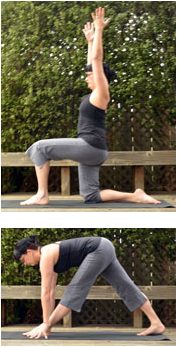 Lunge to Parsvotannasana (Intense Stretch of the West Side of Body) Begin on all fours and bring left foot between hands. Inhale sweep arms forward and up overhead pressing pelvis forward. Exhale and touch floor on either side of foot as you lift left knee off floor and straighten both legs. You may also use blocks under the hands if it is difficult to reach the floor. Repeat to both sides 5 times with the breath.  Vrksasana (Tree Pose) Stand with feet hips-width apart. Engage legs and bear weight on left leg only. Draw right foot onto calf or inner thigh (do not press on side of knee). Press foot against leg and leg against foot. Draw belly in and release tail bone towards floor. Inhale and draw arms overhead without gripping shoulders. Hold as long as you can balance with comfort, release and change sides. 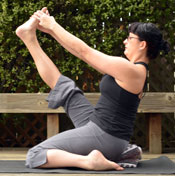 Krounchasana (Heron Pose) Sit on a block with the left leg in Virasana and the right foot on the floor. If you cannot sit in Virasana, sit cross-legged with the left leg. Either wrap strap around sole of foot or hold sole of foot with both hands. Inhale open chest and lean back taking left foot off floor and bringing left knee to chest. Exhale and extend the left leg straight. Hold 10-20 breaths then release and change sides. Anantasana (Vishnu's Couch) Lie on the right side with knees slightly bent. Draw left knee into the chest and strap foot then straightening the leg towards the ceiling keeping the leg externally rotated. You can hold the head with the right hand. Also try to straighten the bottom leg and balance on the side body. Hold for up to 2 minutes, then release and change sides. Supta Upavista Konasana (Reclining Wide Legged Forward Bend) Lie on the back with the buttocks about 6 inches from the wall. Support the legs in a straddle position on the seat of two chairs with blankets folded over the seats for cushion. Rest for up to 10 minutes. Our knees are a vulnerable joint in the body and stability around the knees is crucial when practicing yoga and participating in many of our daily activities such as walking, getting in and out of a seated position and climbing the steps. The knee is a hinge joint, and like the elbow, it only moves in two directions, flexion (bent) and extension (straight). Unfortunately many injuries occur when the knee is impacted from the side and the knee twists which puts stress on the meniscus, the disc between the femur bone of the upper leg and the fibula and tibia of the lower leg, or the ligaments that hold the knee together. This week we will discuss how stretching the calves and hamstrings and strengthening the quadriceps can help to build strength around the knee. You will also learn some tricks on how to deal with arthritis knee pain and hyper-extended knees while practicing standing postures in yoga. 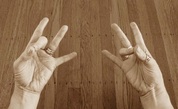 Vyana Vayu Mudra (Marma Mudra) Right Hand: Touch tip of thumb and ring fingers together, extend all others Left Hand: Touch tips of thumb and middle fingers together, extend all others. Rest hands with palms up. Benefits: Draws energy into the joints Practice Tips: Good for arthritis 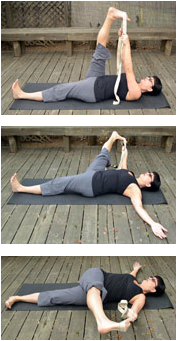 Supta Padangusthasana (Reclining Big Toe Pose) Lie on the back with the legs straight. Variation I: Draw your right knee into your chest and lengthen the left leg onto the floor. Wrap a strap around the ball of your right foot and extend the leg into the air. Reach the hands up the strap until the elbows are straight but the shoulders are still grounded. Variation II: Hold the strap in the right hand and place a block on the outside of the right hip. Externally rotate your leg and as you exhale, lower the leg directly out to the side so that the outer thigh rests on the block. Extend the foot into the strap and reach the left arm out to the side keeping the left hip on the floor. To release, use the inner thigh to draw the leg up to center. Variation III: Hold the strap in the left hand and slowly bring the leg across the body as you twist the lower body, keeping the shoulders on the floor and the right arm out to the side. To release, drop the right hip into the floor and allow the leg to follow. Hold each variation for 10-20 breaths. Deviasana (Goddess Pose) @ Wall Lie on the back with feet on the wall and knees bent at a 90 degree angle. Step feet wide apart and turn toes out, keeping knees lined up with the ankles. Press into the wall alternately with the feet, then press into the wall with both feet. Supta Virabhadrasana II (Reclining Warrior II) Lie on back with feet in Deviasana. Slightly turn pelvis towards the right and extend left leg out and straighten left knee. If you can turn left toes to face the ceiling or inward toward the midline of your body. Extend arms out to the sides as you would in a standing Virabhadrasana II. Press the feet into the wall, make sure there is no pain or pulling on either knee. Hold for 5-10 breaths, then change sides. 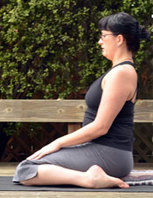 Virasana (Hero Pose) Sit on block or blanket between heels. Ground front of feet and shins, thighs and sit bones into earth. Lift up through belly, heart and crown of head. For Ankle Pain - Kneel on folded blanket with crease of ankles at edge of blanket). For Knee Pain - Sit higher so knees do not have to bend all the way. 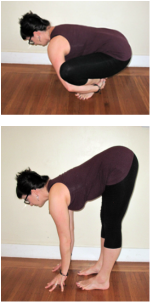 Malasana (Garland Pose) to Ardha Uttanasana (Half Forward Bend) Begin squatting with feet turned out. If heels do not come to the floor, use a rolled blanket under heels. You may also choose to sit on a block for greater stability and you do not have to reach for the heels as shown in the picture. Place a block in front of your feet and as you exhale the breath, lift pelvis and drop the heels as you come into Ardha Uttanasana. As you inhale come back down into the squat. Repeat up to 5 times with the breath.  Virabhadrasana II (Warrior II) Variation Stand with feet wide apart and turn right foot in and left foot out. Roll up a sticky mat and place it between the left lower leg and the wall as you bend the left knee and press knee into the rolled mat (rolled mat drawn in purple). Inhale and lift the arms to shoulder's height and hold for 5-10 breaths, then change sides. For Arthritic Knees: You may place a yoga wedge under the ball of the front foot so that the front of the foot is tilted upwards. This propping will take some of the pressure off of the base of the knee and allow the quadriceps muscles to work a bit more to hold you in the position (wedge drawn in purple). 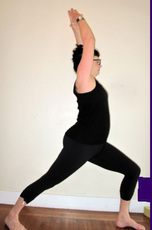 Virabhadrasana I (Warrior I) Variation Stand facing the wall and step the right foot forward and placing block between shin an the wall, bend the knee into the block. Step left foot back turning toes slightly back keeping hips width distance between feet. Press hands into wall at chest height and then either bring hands to the heart or rasie arms overhead. Hold for 10 breaths, then change sides.  Trikonasana (Traingle Pose) VariationStand with feet wide apart. Turn left out to 90 degrees and right foot in 30 degrees. Inhale arms out from shoulders. Exhale and cock hips to the left. Reach left arm parallel to floor to lengthen the left waist and bring left hand on block, foot or floor. Rotate the chest towards the right and reach right arm towards ceiling. Hold 5-10 breaths then release and change sides. For Hyper-extension of Knees: Sllightly bend front leg and place small face of block against calf, then re-straighten leg catching block between leg and floor so that you cannot hyperextend the knee.  Prasarita Padottanasana (Wide-Legged Forward Bend) Stand with feet wide apart. Bend forward from hips placing hands between feet. Release spine forward with crown of head facing floor. Hold up to 1 minute, then return to standing by drawing hands onto hips and lifting entire torso up as a single unit.  Supported Constructive Rest Lie on back with balls of feet on edge of folded blanket and a second blanket under the head. Place looped strap around lower thighs hips width apart and place block between knees. The leg props should be placed so that the legs can completely relax. Rest 5-10 minutes |
Index:Archives:
September 2022
I attend Cheryl's class regularly and feel that my practice has improved immensely over the past few years due to her expert coaching. Her teaching style is clear and compassionate and her previous experience in teaching adults is evident in her organized approach and easy to understand instructions. I also appreciate that Cheryl not only teaches us about how to correctly position ourselves, but also touches on many aspects of yoga philosophy, which in turn has deepened my personal practice and heightened my awareness of the connection between mind and body, breath and relaxation. |



 RSS Feed
RSS Feed
